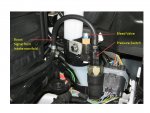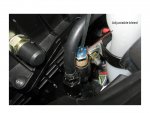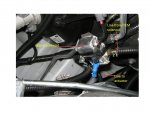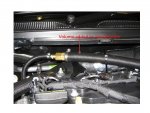Driving round with a boost gauge fitted showed what I would call lazy response from the turbo system in the way boost pressure builds.
What I noticed was even when the engine rpm was high enough to produce maximum boost, it you nailed the throttle hard the boost pressure was slow to increase .
I decided to try and do something about this slow response. I didn't want to increase the maximum factory pressure, just make it build faster.
The first thing I tried was to add some volume to the wastegate actuator line. This is not a new idea. It simply involves teeing into the actuator line and adding volume causing a delay before the actuator can responded to the boost signal. This proved to be not very effective. The OEM system response very quickly and overrides the delay.
For anyone who does not know how the OEM ECU controls boost pressure it works something like this.
An electrical controlled pneumatic solenoid fits between the boost signal line and the wastegate actuator, the ECU opens and closes the solenoid rapidly to obtain the targeted boost pressure. It is referred to as duty cycle. Not only does it control the targeted pressure it controls to an extend how quickly boost pressure builds by varying the duty cycle. That's a basic explanation.
What I decided to do because I had the parts I needed from years of collecting bits and pieces was to block the boost signal to the actuator using a separate solenoid until a certain boost pressure was reached and then allowing the OEM system to operate as normal.
I fitted a 3 port boost solenoid between the OEM boost control solenoid and the wastegate actuator.( I also decided to keep the extra volume in the wastegate actuator line) This added solenoid was in the normally open position and powered to close and block the boost signal pressure. I then fitted a pneumatic pressure switch which received its boost signal from the intake manifold through a hose fitted with a one-way check valve to prevent any vacuum leaks.
This pneumatic pressure switch was set in the normally close position and powered up when the engines was running. It sent current to the added boost solenoid and held the boost solenoid in the closed position until boost pressure in the intake manifold reached 5psi, at that pressure the circuit would open and also allow the added boost solenoid to open and allow boost signal pressure to the wastegate actuator. With me so far?.
There is one more trick to the system. Teeing into this pneumatic pressure switch is an adjustable bleed valve that allow me to adjust the pressure at witch the valve opens the circuit. For example, if I bleed off 3psi of pressure then valve opens the circuit at 8psi intend of 5psi.
I bench test the system before installing it and set the bleed valve at 2.5 turns from the fully closed position. This produced around 8psi of intake manifold pressure before the circuit opened and operated as normal.
Road testing show that accelerating slow to moderately produced very little difference to the speed turbo boost pressure increased. It was only when you nailed the throttle hard that there was a definite change. If you nailed the throttle hard in 2nd gear for example, boost pressure would rise quickly to around 20psi before the OEM system regained control and drag it back. 3rd gear around 22psi before it would pull back.
I got my first CEL when making a further adjustment to the bleed valve, another ? of a turn taking it 2.75 turns out from closed was all it took. A quick trip to the Ford dealer showed an over boost logged. Reset and cleared the fault code and adjusted the bleed valve back to 2.5 turns.
I had no further CELs till I fitted the CP-E catted down-pipe I had purchased. Straight away the first time I drove the car and gave it WOT in 3rd and 4TH gear it over boosted and caused a CEL. Adjusting the bleed valve back to 2 ? stop the CEL from reoccurring. These CELs could be reset by switching the ignition off and on. I expect I have do a further adjustment to the bleed valve when I change the exhaust from the cat back.
Eventually when I get a tune I will probably remove the system depending on how fast my boost pressure responds to throttle input.
I would not expect or recommend anyone to carry out the above modification, its not economical for a start, the 3 port boost solenoid I used retails for about $150 AUD alone. Its also really not as effective as I would like thanks to the sophistication of the way the OEM system maps boost pressure.
I only use 98 RON and keep my ears open for detonation. Modifications like the above are not without risk, detonation from over boosting can cause serious engine damage. Over speeding the turbocharger can lead to a premature failure.




What I noticed was even when the engine rpm was high enough to produce maximum boost, it you nailed the throttle hard the boost pressure was slow to increase .
I decided to try and do something about this slow response. I didn't want to increase the maximum factory pressure, just make it build faster.
The first thing I tried was to add some volume to the wastegate actuator line. This is not a new idea. It simply involves teeing into the actuator line and adding volume causing a delay before the actuator can responded to the boost signal. This proved to be not very effective. The OEM system response very quickly and overrides the delay.
For anyone who does not know how the OEM ECU controls boost pressure it works something like this.
An electrical controlled pneumatic solenoid fits between the boost signal line and the wastegate actuator, the ECU opens and closes the solenoid rapidly to obtain the targeted boost pressure. It is referred to as duty cycle. Not only does it control the targeted pressure it controls to an extend how quickly boost pressure builds by varying the duty cycle. That's a basic explanation.
What I decided to do because I had the parts I needed from years of collecting bits and pieces was to block the boost signal to the actuator using a separate solenoid until a certain boost pressure was reached and then allowing the OEM system to operate as normal.
I fitted a 3 port boost solenoid between the OEM boost control solenoid and the wastegate actuator.( I also decided to keep the extra volume in the wastegate actuator line) This added solenoid was in the normally open position and powered to close and block the boost signal pressure. I then fitted a pneumatic pressure switch which received its boost signal from the intake manifold through a hose fitted with a one-way check valve to prevent any vacuum leaks.
This pneumatic pressure switch was set in the normally close position and powered up when the engines was running. It sent current to the added boost solenoid and held the boost solenoid in the closed position until boost pressure in the intake manifold reached 5psi, at that pressure the circuit would open and also allow the added boost solenoid to open and allow boost signal pressure to the wastegate actuator. With me so far?.
There is one more trick to the system. Teeing into this pneumatic pressure switch is an adjustable bleed valve that allow me to adjust the pressure at witch the valve opens the circuit. For example, if I bleed off 3psi of pressure then valve opens the circuit at 8psi intend of 5psi.
I bench test the system before installing it and set the bleed valve at 2.5 turns from the fully closed position. This produced around 8psi of intake manifold pressure before the circuit opened and operated as normal.
Road testing show that accelerating slow to moderately produced very little difference to the speed turbo boost pressure increased. It was only when you nailed the throttle hard that there was a definite change. If you nailed the throttle hard in 2nd gear for example, boost pressure would rise quickly to around 20psi before the OEM system regained control and drag it back. 3rd gear around 22psi before it would pull back.
I got my first CEL when making a further adjustment to the bleed valve, another ? of a turn taking it 2.75 turns out from closed was all it took. A quick trip to the Ford dealer showed an over boost logged. Reset and cleared the fault code and adjusted the bleed valve back to 2.5 turns.
I had no further CELs till I fitted the CP-E catted down-pipe I had purchased. Straight away the first time I drove the car and gave it WOT in 3rd and 4TH gear it over boosted and caused a CEL. Adjusting the bleed valve back to 2 ? stop the CEL from reoccurring. These CELs could be reset by switching the ignition off and on. I expect I have do a further adjustment to the bleed valve when I change the exhaust from the cat back.
Eventually when I get a tune I will probably remove the system depending on how fast my boost pressure responds to throttle input.
I would not expect or recommend anyone to carry out the above modification, its not economical for a start, the 3 port boost solenoid I used retails for about $150 AUD alone. Its also really not as effective as I would like thanks to the sophistication of the way the OEM system maps boost pressure.
I only use 98 RON and keep my ears open for detonation. Modifications like the above are not without risk, detonation from over boosting can cause serious engine damage. Over speeding the turbocharger can lead to a premature failure.




